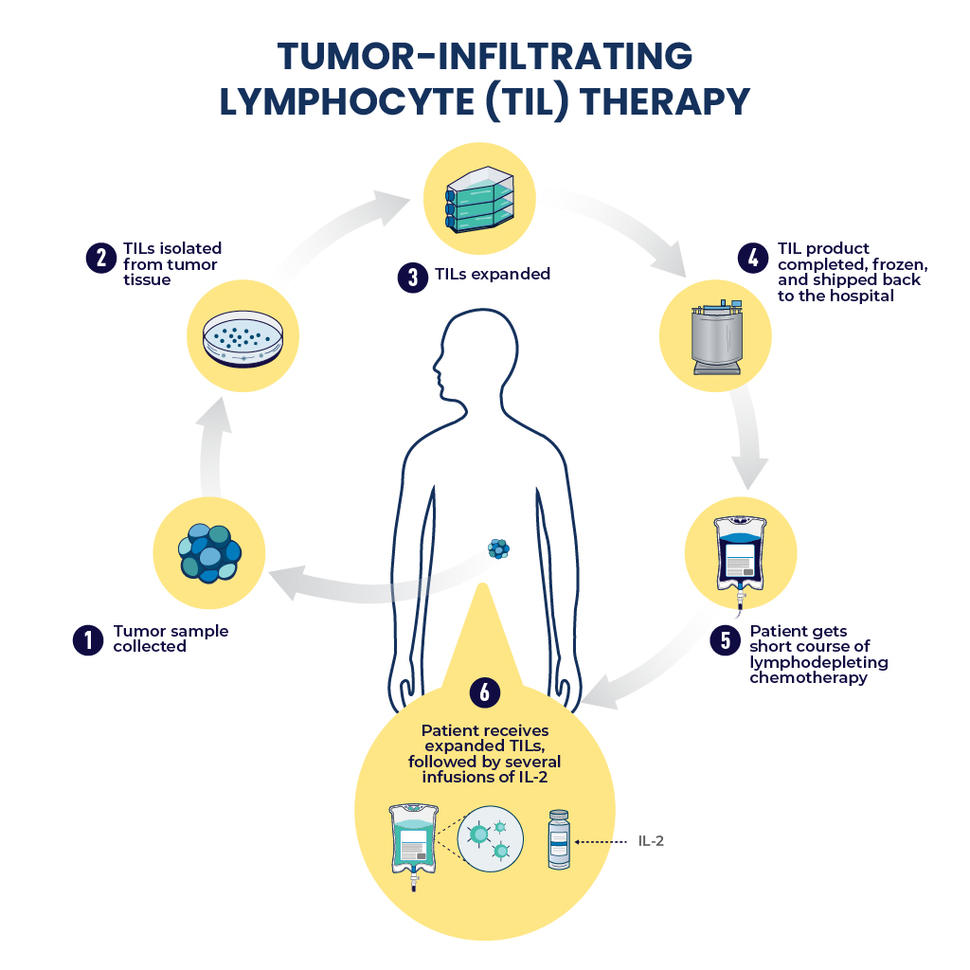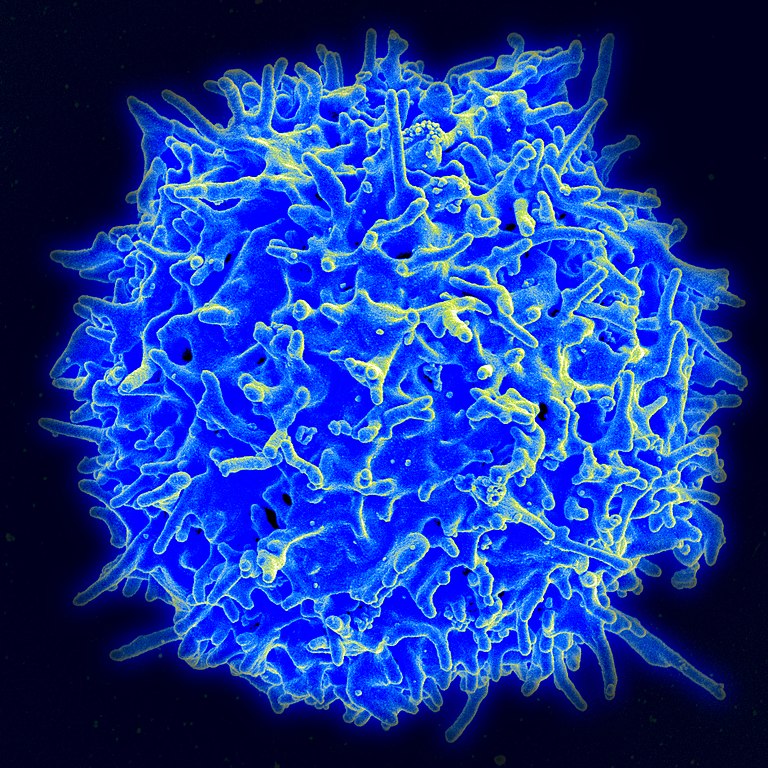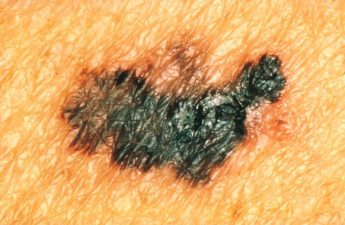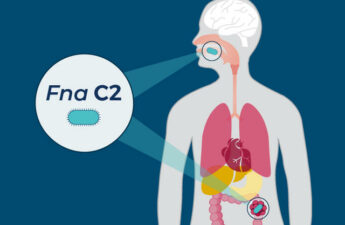March 5, 2024, by Carmen Phillips
National Cancer Institute
In an event more than three decades in the making, the Food and Drug Administration (FDA) has approved lifileucel (Amtagvi), the first treatment for cancer that uses immune cells called tumor-infiltrating lymphocytes, or TILs. Announced on February 16, the agency’s decision also makes lifileucel the first cellular therapy to be approved for a solid tumor, the skin cancer melanoma.
The agency’s accelerated approval covers the use of lifileucel for people with advanced melanoma that has gotten worse after treatment with certain immunotherapy drugs or targeted therapies.
As is the case with CAR T-cell therapy, another type of cellular therapy, lifileucel is made using a patient’s own T cells. And with both therapies, the cells are collected at the hospital where the patient is being treated but are sent away to be manufactured into the final treatment.
But there’s a key difference between TILs and CAR T-cell therapies.
For the approved CAR T-cell therapies, the T cells are collected from a patient’s circulating blood. For TIL therapy, by contrast, the T cells are collected from the patient’s tumor.
Lifileucel’s approval was based on findings from a clinical trial sponsored by Iovance Biotherapeutics. Among more than 70 participants who were treated with the lifileucel dose ultimately approved by FDA, nearly one-third had at least some reduction in the size of their tumors (a tumor response), with tumors disappearing completely (a complete response) in several participants.
Moreover, about 40% of those whose cancer responded to lifileucel still had no progression of their cancer a year after receiving the one-time infusion treatment.
TIL therapy was pioneered by Steven Rosenberg, M.D., and his colleagues in NCI’s Surgery Branch. In the late 1980s, Dr. Rosenberg led the first-ever clinical trials of TIL therapy, showing that it could shrink tumors in people with very advanced melanoma. (Dr. Rosenberg was recently given the nation’s highest award for technology and innovation for his work on immunotherapy, including the development of TIL therapy.)
Over the ensuing years, the NCI researchers further refined the process for manufacturing and delivering TIL therapy. In 2011, NCI entered into a cooperative research agreement with Iovance to further develop this particular TIL therapy, including conducting larger clinical trials and developing a manufacturing infrastructure, paving the way for FDA approval.
It’s been a long time coming, Dr. Rosenberg acknowledged. The new approval “is a big step,” he said, one which demonstrates that “cellular therapy is joining the mainstream of cancer treatment.”
TILs that just need a little help
Six different CAR T-cell therapies have been approved by FDA, all of which are used to treat blood cancers like leukemia and lymphoma.
With CAR T-cell therapy, the collected immune cells undergo genetic engineering in the laboratory to give them the ability to recognize cancer cells and enhance their ability to kill them. Next, they are grown, or expanded, into the hundreds of millions, and then infused into the patient.

With lifileucel, the collected T cells are not engineered before being expanded. That’s because, having been collected from samples of tumor tissue, they’ve already proven that they can recognize and navigate to tumors, Dr. Rosenberg explained. That recognition relies on the presence of specific abnormal proteins, or antigens, on the surface of the tumor cells.
But, like a robber who sneaks into a bank but doesn’t have the tools to open the safe, the collected TILs lack the ability or support required to complete the job. What the TILs need are reinforcements—a lot of them—and some encouragement.
So, although the TILs collected from a patient’s tumor are not genetically changed, there are steps taken during the manufacturing process—including mixing them with a drug called IL-2—to help them expand into billions of cancer-fighting immune cells.
In addition, as part of lifileucel treatment, two measures are taken to enhance the infused TILs ability to attack the cancer and their overall potency. First, in the days prior to receiving lifileucel, patients undergo a few rounds of high-dose “lymphodepleting” chemotherapy. And, second, shortly after the lifileucel infusion, they are given several doses of IL-2.
Long-lasting tumor responses to lifileucel
FDA’s approval was based on data from a group of 73 patients in the trial whose cancer had gotten worse despite treatment with a PD-1/PD-L1-targeted immune checkpoint inhibitor or a BRAF inhibitor and whose lifileucel dose was at least 7.5 billion cells (the dose specified in the approval).
Longer-term findings from a larger group of 153 patients in the trial were reported in December 2023 at the European Society of Medical Oncology’s (ESMO) 2023 Immuno-Oncology Congress, and they largely mirror the findings from these 73 patients.
Of the 48 people (31.5%) whose cancer responded to treatment with lifileucel, more than half have lived at least a year without any evidence of their cancer getting worseExit Disclaimer. About 10% of these responses are ongoing—that is, there continues to be no evidence that their cancer is getting worse—and nearly all have lasted several years.
The longest lasting response is nearly 5 years, one of the trial’s lead researchers, Martin Wermke, M.D., Ph.D., of the University of Dresden in Germany, reported at the ESMO meeting.
The researchers plan to follow all patients for 5 years from the time of their lifileucel infusion, Dr. Wermke said. Based on the results thus far, he continued, the researchers anticipate that cancer will not get worse or come back in any participants with ongoing responses.
Who will respond to lifileucel? What about side effects?
There are some hints from the results in the larger patient group that might help identify who is most likely to respond to lifileucel, Dr. Wermke explained.
For example, few people whose cancer had spread to the brain or liver, which was the case for about half of the 153 patients, responded. Responses were also unlikely in people who had larger tumor burdens—that is, a substantial amount of cancer in their body.
These findings, he noted, suggest that lifileucel might be most effective if it’s given before the cancer has spread to many other parts of the body or individual tumors have become quite large.
All participants in the trial had side effects caused by the treatment, Dr. Wermke reported. Most, however, were not dangerous and were largely caused by the chemotherapy given before the lifileucel infusion and IL-2 given afterward. The most common included anemia, high fevers, and substantial drops in levels of platelets and certain white blood cells.
TIL therapy does not appear to cause the often serious immune-related side effects commonly seen in people treated with CAR T-cell therapy, including cytokine release syndrome and neurologic effects, Dr. Wermke said.
He also stressed that the side effects seen in the trial had a consistent and familiar pattern.
“They’re all occurring during the first 2 or 3 weeks” after someone receives the treatment, he said.
“There are hardly any new [side effects] occurring in the long term,” he said.
From clinical trials to using TILs in everyday cancer care
Iovance announced that it has approved more than 30 treatment centers across the United States to collect tumor samples for making lifileucel and administering the final treatment to patients. There are expected to be 50 such centers by the end of May.
Initially, all treatments will be manufactured at an Iovance facility or a contracting facility, both in Philadelphia.

One CAR T-Cell Therapy for Blood Cancers?
According to the company, a single treatment with lifileucel will cost $515,000. During a company webcast held after the approval, Iovance officials said they expect that many insurance companies will cover the treatment at the same levels as they have for CAR T-cell therapies, which also cost hundreds of thousands of dollars. The company has also established a financial assistance program for patients.
William Sharfman, M.D., a co-director of the melanoma program at the Johns Hopkins Sidney Kimmel Cancer Center, said the approval is “very exciting” news for people with advanced melanoma.
But, Dr. Sharfman cautioned, “there are several limiting factors” for using lifileucel in patients.
Among them, he said, is that patients need to be relatively healthy to receive it, which isn’t always the case for people with advanced cancer who have undergone other treatments.
“Patients really need to have normal heart and lung function,” he said.
Alexander Shoushtari, M.D., of Memorial Sloan Kettering Cancer Center, who studies cellular therapies, agreed that practical considerations may limit lifileucel’s use.
“The relatively high doses of … chemotherapy given before treatment and the high dose Interleukin-2 after [lifileucel] infusion currently limit the types of people who can undergo it,” Dr. Shoushtari said.
After lifileucel approval, what comes next?
FDA’s approval for melanoma is only the first step for lifileucel. Iovance has already started enrolling participants in a large trial combining lifileucel with the immunotherapy drug pembrolizumab (Keytruda) as an initial treatment for advanced melanoma.
Lifileucel is also well along in testing as a treatment for other cancers, including showing promising tumor responses in people with advanced lung cancer, as well as ovarian and head and neck cancers.
Dr. Rosenberg’s lab and others are testing newer forms of TIL-based therapies in clinical trials, and not just for melanoma, but for other solid cancers.
“There are clear examples where TIL therapy has caused regression of [other solid] tumors,” Dr. Rosenberg said. That includes complete eradication of tumors in individual patients with advanced colon cancerExit Disclaimer and advanced breast cancer treated in clinical trials at the NIH Clinical Center.
With this “landmark approval” in hand, there is a lot of optimism surrounding TIL therapy and cellular therapy more broadly, Dr. Shoushtari said. “I expect that this [approval] will be the tip of the iceberg for cellular-based immune therapy for solid tumors,” he added.
The first-generation TILs like lifileucel are “an important advance and proof of concept” that these treatments can be highly effective, he said. “But much remains to be done to broaden [their] use, both for other cancer types and to a broader range of people with melanoma.”
Dr. Sharfman agreed. “That is the challenge: to design better TILs.”
Researchers are already taking up this challenge, include finding ways to make TILs that are more potent and that can be used in a broader range of solid tumors. Dr. Rosenberg’s group at NCI, for example, has developed a process for identifying TILs that strongly recognize a tumor and are most likely to attack it.
Researchers have also begun genetic engineering of TILs, with the goal of increasing the number of people who respond to the treatment or eliminating the need for the pre-infusion chemotherapy or post-infusion IL-2.
Dr. Rosenberg stressed that the decades of research on cancer cellular therapies by his and other groups has paved the way for rapid advances.
“We now have the knowledge of how to help the immune system target tumors,” particularly the solid tumors “that are responsible for the vast majority of cancer deaths,” he said. “There is a world of opportunities out there.”
Researchers Develop a Potential “Universal” CAR T-Cell Therapy for Blood Cancers was originally published by the National Cancer Institute


